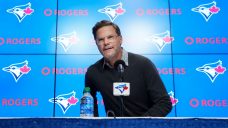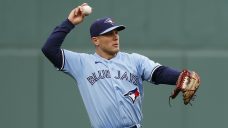TORONTO — Out for breakfast the other day, a stranger one table over leaned in with a question that was really more of a statement — sending Gabriel Moreno to the Arizona Diamondbacks has to be the worst trade in Toronto Blue Jays franchise history.
It’s not, not even close, even if now was the time to judge, which it isn’t, and we’ll get to all that shortly. But that it’s a discussion point I’ve heard often in recent weeks as frustrations from the Blue Jays’ most unsatisfying 89-win, playoff-appearance season linger while Moreno and Lourdes Gurriel Jr. have helped carry the Diamondbacks to the World Series.
Mark Shapiro’s state-of-team news conference Oct. 12 might have helped douse some of the fires set by Ross Atkins five days earlier during the GM’s season-wrap availability. But when the president and CEO confirmed that the Blue Jays would be running things backs with the front office intact, after Atkins confirmed that manager John Schneider would also return, it left everything from 2023 to be re-litigated if improvements are to be made in 2024.
And as a result, the Moreno-and-Gurriel-for-Daulton Varsho deal heads this edition of Blue Jays FAQs.
Q: So, is Varsho for Moreno and Gurriel the worst deal the Blue Jays have ever made?
A: Five words: Michael Young for Esteban Loaiza. That July 19, 2000, trade did more damage to the franchise’s trajectory than any other, trading a future seven-time All-Star shortstop/second baseman for 75 mediocre and indifferent starts from the right-hander. I’d argue that with Young in the mix, the Blue Jays make the playoffs at least once during the 2003-08 window and that might have led to several different decisions at key pivot points. It was a total disaster.
Now, the Blue Jays definitely got less from the Varsho deal in the first season than the Diamondbacks have. A straight look at the WAR numbers via FanGraphs will tell you that Varsho put up a win value of 2.1, the same as Gurriel before you factor in Moreno’s 1.7. But Varsho also did that during a down offensive season, and if he simply hits the way he did in 2022 while playing centre field, suddenly he’s a 4.8-win player and the math looks much different.
As a pending free agent, Gurriel won’t be in the equation from this point onward, so it’s on the Blue Jays to ensure they help Varsho max out, the way Moreno has begun to find himself with the Diamondbacks. That’s where the ledger here lies.
One interesting parallel between the deals is that, both times, the Blue Jays were trading from an area of surplus. When Young was sent to Texas, they also had shortstop prospects Cesar Izturis and Felipe Lopez in the system but they ended up mismanaging all three assets. Izturis and Lopez also became All-Stars after being traded, while the return of Luke Prokopec, Chad Ricketts and Jason Arnold had zero impact.
This time, the Blue Jays traded Moreno while keeping known quantities in Danny Jansen, who is eligible for free agency after 2024, and Alejandro Kirk, who has three years of club control remaining. They sacrificed some future to keep the present stable, but the need for a Jansen extension or an external acquisition behind the plate is on the horizon. This needs to play out more before casting final judgment, but it’s understandably tough to swallow for Blue Jays fans right now.
Q: With Atkins bringing back Schneider, and Shapiro bringing back Atkins, how is anything going to change?
A: Roster moves aside, resolving what Shapiro described as the need for “a higher level of transparency and communication with our players in our preparation and game-planning process” is really the crux of this off-season.
Although this sounds like unintelligible corporate speak, the gaps in that process are what led to some factionalization of the club and the visceral internal reaction to Jose Berrios’ early and ill-fated pull in Game 2 of the wild-card series versus Minnesota.
Undoing the belief that the front office is forcing unpopular in-game moves on the coaching staff won’t be easy, and among the issues at play here is the gap between intention and perception from front office to coaching staff to roster. There will always be differences of opinion on various moves, but retaining trust amid disagreement is essential, especially if the Blue Jays aim to get their hitters back to career-norm production next year.
Q: Is that the plan for how they’re going to get better?
A: Not entirely, but it’s definitely a piece. Tough as it is to believe given the past season, the Blue Jays actually have the makings of a good offence, even with Matt Chapman, Brandon Belt, Kevin Kiermaier and Whit Merrifield poised to hit free agency. It’s not unreasonable for them to factor in some internal improvement at the plate in 2024, particularly from Varsho, Kirk and, especially, Vladimir Guerrero Jr., who this off-season is training for the first time with Nicole Gabriel, a Tampa-based trainer who also works with Randy Arozarena and Adolis Garcia, among others. If the Blue Jays get peak Guerrero alone, they’re a totally different offence, you know that Bo Bichette expects to be better, George Springer should offer more than he did this year and if Jansen could ever find a way to have a full season …
Then there are additions. I’d expect the Blue Jays to try to plug roster holes internally from a group that includes Davis Schneider, Spencer Horwitz, Ernie Clement, Orelvis Martinez, Addison Bager and Nathan Lukes, while Canadian Damiano Palmegiani is quickly bashing himself into the mix. But more slug is essential and they’ll be on that, as they never replaced the lost impact of Teoscar Hernandez and Gurriel, who some around the team feel was the bigger loss because he can both hit different types of pitching and provided a positive influence on Guerrero. That’s three very doable pathways to better run production.
Q: Getting players means spending more money. How much will they have to work with?
The Blue Jays, obviously, aren’t going to give us an exact number, but given that Shapiro said he’s not expecting “a dramatic philosophical shift in payroll next year” and added the team was likely “to stay in the same area, we can support that for now,” let’s do some math and ballpark what they can do.
This year, they were at roughly $250 million for competitive balance tax, or CBT, purposes, crossing the first luxury tax threshold, set in 2023 at $233 million, for the first time. Next year, the first threshold is $237 million and the second is $257 million, and I’d guess the Blue Jays again are closer to the second line than the first.
Already on the books is the roughly $115 million the Blue Jays have locked in for seven players, and they have 13 arbitration-eligible players projected to earn about $61.4 million by MLB Trade Rumors. Add in estimates of $8 million for 0-3 service-time players, $2.5 million for 40-man players in the minor leagues, about $17 million in player benefits and $1.7 million for the pre-arb bonus pool — all numbers that count against the CBT — and you’re at roughly $205 million.
If they’re around $250 million again, that’s about $45 million to work with, which is a decent amount, although there are a lot of holes to fill.
Q: Are they going to bring any of their free agents back?
I wouldn’t rule it out, but I wouldn’t count on it either, especially after Atkins had what seemed like a slip of the tongue during his season-wrap newser and described his pending position player FAs in the past tense (he later tried to walk that back and also made a point of suggesting Hyun Jin Ryu could be an alternative for the team). The market will dictate what happens there, but the most intriguing internal call the Blue Jays have is on reliever Chad Green, whose cleverly constructed contract contains a series of options that play out in the five days after the World Series ends.
First, the Blue Jays get a club option covering the 2024-26 seasons for $27 million over three years plus performance bonuses. If they decline, Green gets a player option for the 2024 season worth $6.25 million with up to $2 million in bonuses based on games pitched. If he declines, the Blue Jays get a final $21-million, two-year club option covering 2024-25 plus bonuses.
The expectation is that Blue Jays will exercise one of their options as Green will decline his player option knowing he’d do far better in free agency. Whichever option the team chooses will eat into its available spending money and the question becomes, does management prefer the lower annual-average value of the three years or shorter commitment but higher annual spend of the two-year option.
Q: What about long-term extensions for Guerrero and Bichette?
A: At this point, it’s hard to imagine Guerrero and the Blue Jays finding common ground on an extension that would keep him from free agency after the 2025 season. While the All-Star first baseman had a better year than he’s getting credit for, especially since he played through wrist and knee issues, his ceiling is certainly higher and players don’t usually sign long-term deals coming off below-peak seasons. The Blue Jays, too, would understandably be reluctant to make a nine-figure commitment to a player who’s had one MVP-calibre season out of five years in the majors, pushing both sides to go year to year. The thing is, if Guerrero is back in top form next year and the Blue Jays want to do an extension then, the allure of the open market would be just one year away and it’s harder to find a financial sweet spot at that point. Maybe something changes in the next few months, but that’s my read on where things stand right now.
As for Bichette, the extension he did in the spring covering his arbitration-eligible years takes away the natural discussion points of arbitration, so the Blue Jays would have to be intentional in launching talks and engage him with a meaningful proposal for any realistic chance of success. I do believe the way the club avoided a hearing with the All-Star shortstop last spring was essential in keeping this possibility remotely open. But I wonder if both sides here will need the open market to help define a longer-term number, which is why the fall of 2025 is developing into a tipping point winter.
Q: Beyond paying the luxury tax, does becoming a CBT-playing club have any other ramifications for the Blue Jays?
A: Yes. There are two key ones. First, the Blue Jays will face a stiffer penalty this year if they sign a free agent who rejected a qualifying offer, as they did a year ago when they landed Chris Bassitt and gave up their second-round pick. This winter, they’d have to surrender two draft picks — second- and fifth-rounders — plus forfeit up to $1 million in international bonus-pool money. Both are exceptionally damaging to their efforts to rebuild the farm system.
Second, if the Blue Jays lose a qualified free agent — Chapman will be the only one to apply here — their compensatory pick will come after the fourth round rather than a selection just before the third round.







COMMENTS
When submitting content, please abide by our submission guidelines, and avoid posting profanity, personal attacks or harassment. Should you violate our submissions guidelines, we reserve the right to remove your comments and block your account. Sportsnet reserves the right to close a story’s comment section at any time.